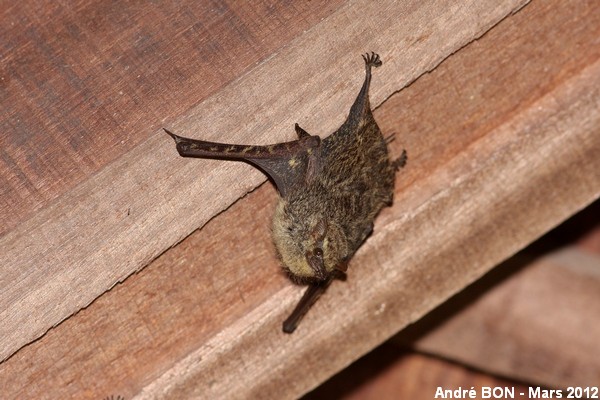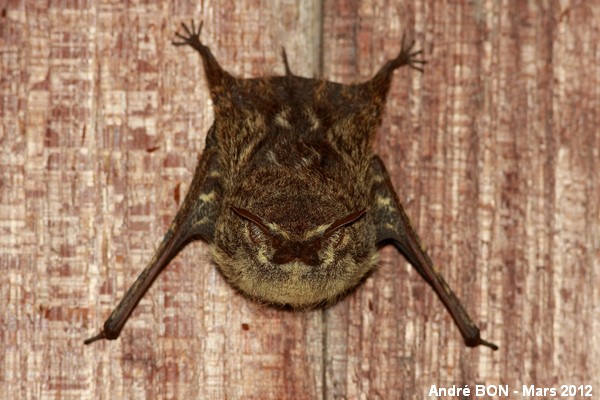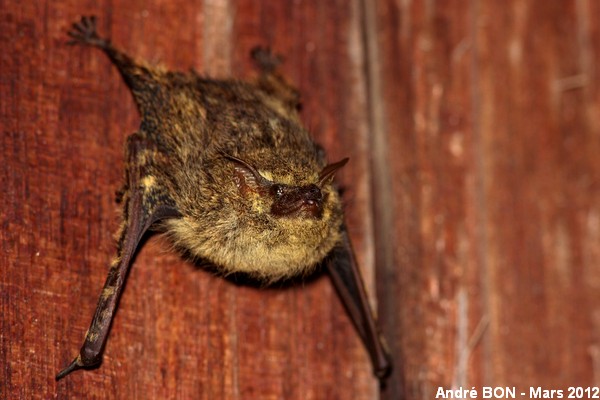


| Proboscis Bat (Rhynchonycteris naso (Wied-Neuwied, 1820)) |



|
|
Scientific name: Rhynchonycteris naso (Wied-Neuwied, 1820) Common name: Proboscis Bat Other names: Brazilian Long-nosed Bat, Sharp-nosed Bat French name: Chauve-souris à long nez, Chauve-souris à trompe Family: Emballonuridae Size: Length of about 6 cm for a weight of 4g. The fore arm is from 35 to 41 mm long. Biotope: Places near or above rivers with slow running water and occasionally ponds or marshes. Proboscis Bats roost in well lighted places, on trunks or roots located over water per example. Food: Small insects caught in flight over water from the surface to a height of about 3 metres. Longevity : Estimated at about 6 years (with reserves) by comparison with similar species. Geographic area: Central America and South America east of the Andes, from southern Mexico south to Peru, northern Bolivia and south-eastern Brazil. |
As indicated by its common name the Proboscis Bat is characterized by its elongated nose resembling a small trump. It shows a dense brown grey fur on the back and paler brown grey on the under parts. The patagium (membrane of skin used to fly) is dark brown. The back is marked with two white wavy lines. The ears are dark brown and prominent. Proboscis Bats live in small colonies of 3 to 45 individuals and sometimes more( colonies of about 100 individuals have been found). These bats are sometimes found roosting in a row along one trunk or root in case of small groups. They are active during the night. Reproduction occurs all year round except maybe at the dry season. Each reproductive female gives birth to only one young but generally twice a year. There is a possible confusion with the Greater Sac-winged Bat (Saccopteryx bilineata) or the Lesser Sac-winged Bat (Saccopteryx leptura). You can tell the Proboscis Bat apart with its long nose but also with a row of tufts of light-coloured hairs regularly spaced along the fore arms. |
| [To know more about the Proboscis Bat] [Next picture] [Top] |

|
I have shot this picture at the "Salines" of Rémire-Montjoly. These Proboscis Bats were roosting under the roof of a small observation hut located at the centre of a small pond. I have found a mention of their presence accompanied with the species name on an information sheet describing this natural place. The identification of the species is confirmed on this picture by the long nose and also by the tufts of pale hairs regularly spaced on the fore arm. |
| [To know more about the Proboscis Bat] [Next picture] [Previous picture] [Top] |

|
I have observed 4 or 5 bats here. You can clearly see the two white wavy lines on the back. They are also found on Saccopteryx bilineata and Saccopteryx leptura. |
| [To know more about the Proboscis Bat] [Previous picture] [Top] |

|
I wonder if the bats disturbed on trunks bordering the "Crique Gabriel", while paddling against the current in a canoe, or those flying low over water at nightfall in the Marshes of Caw are of the same species. |